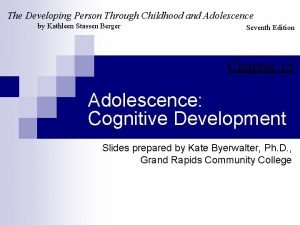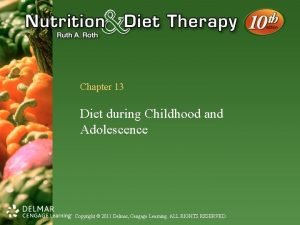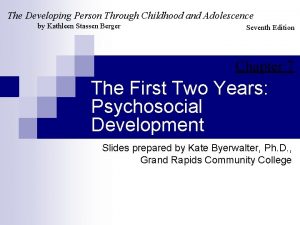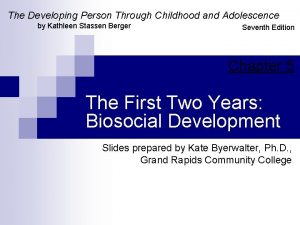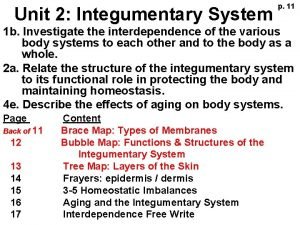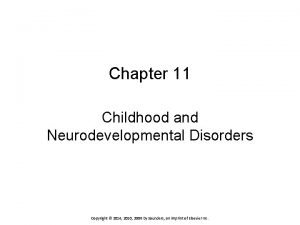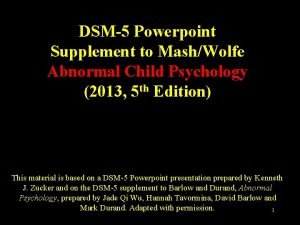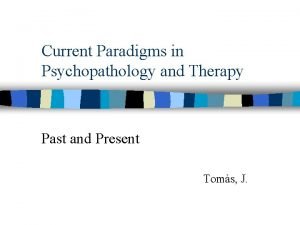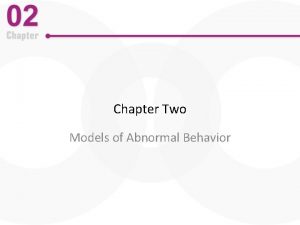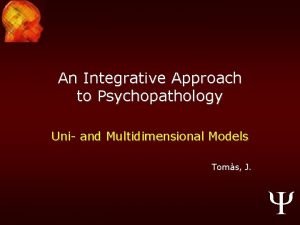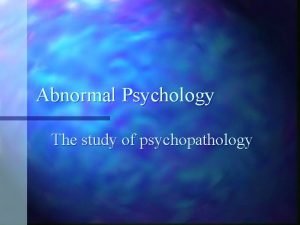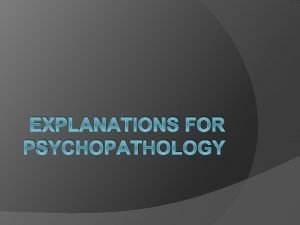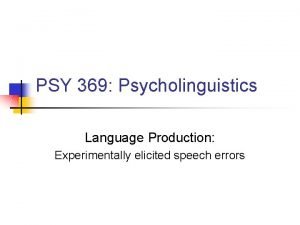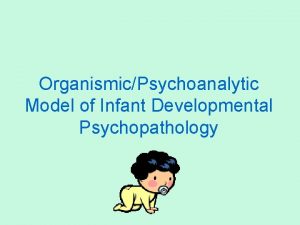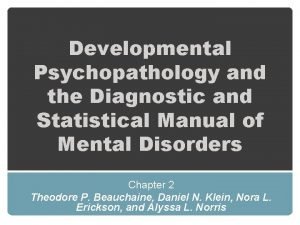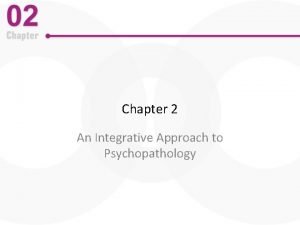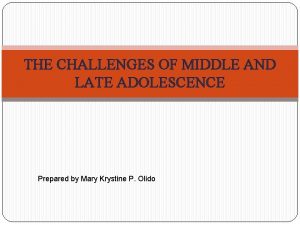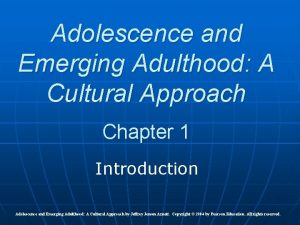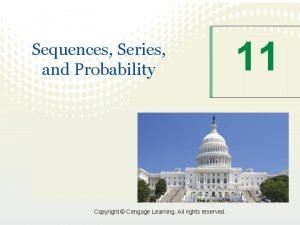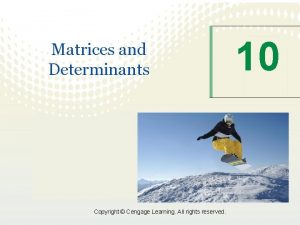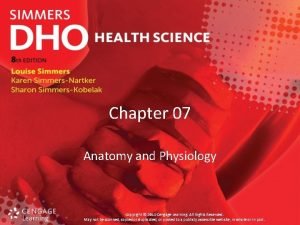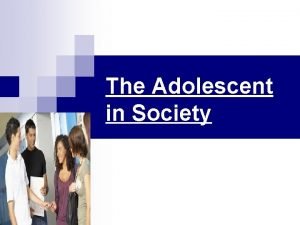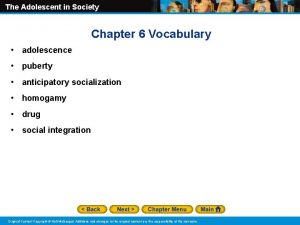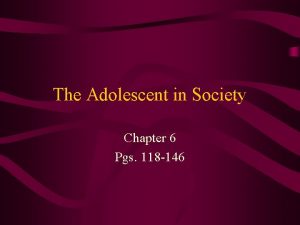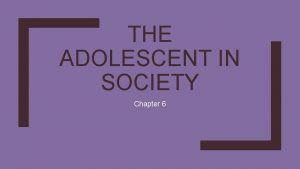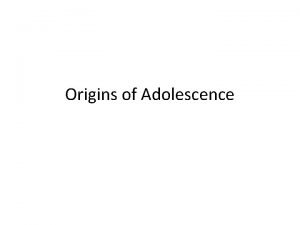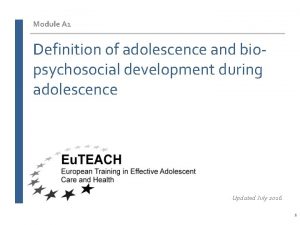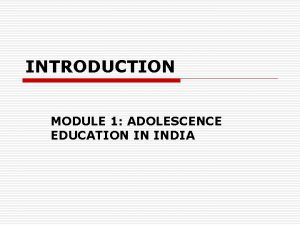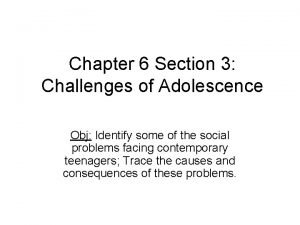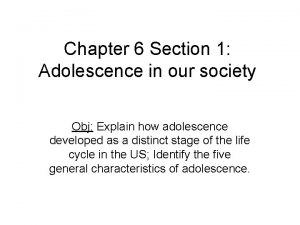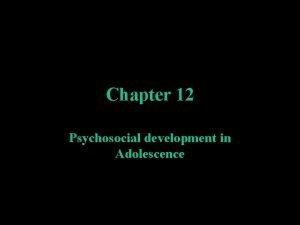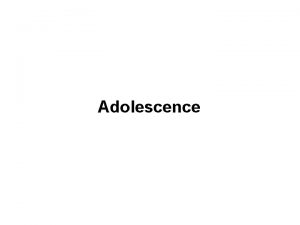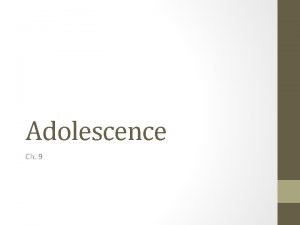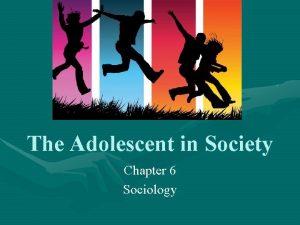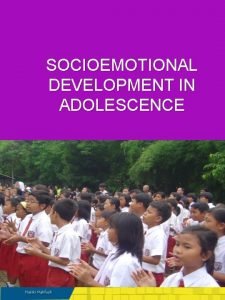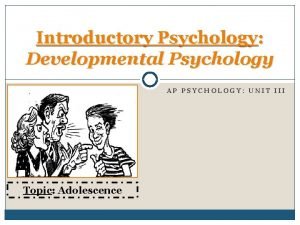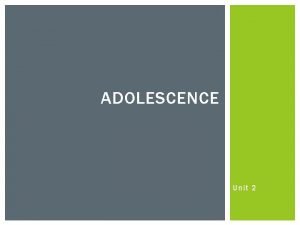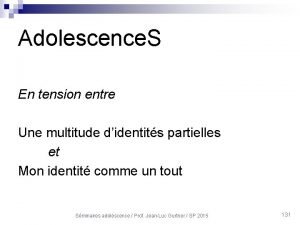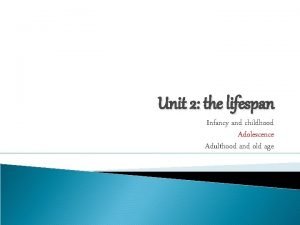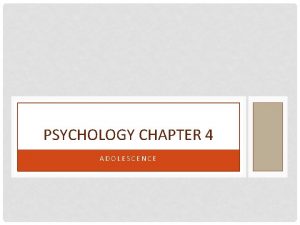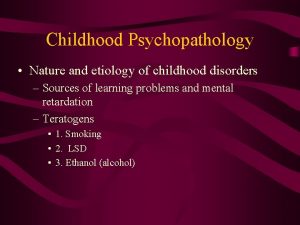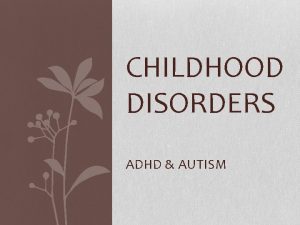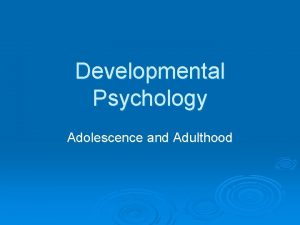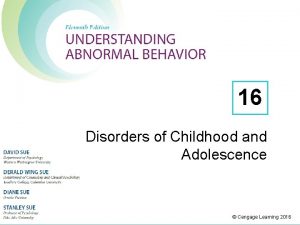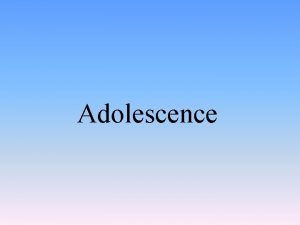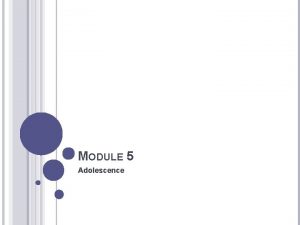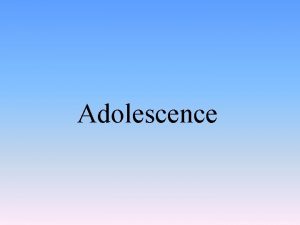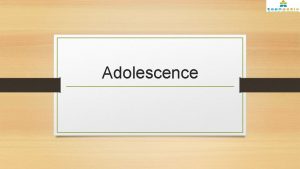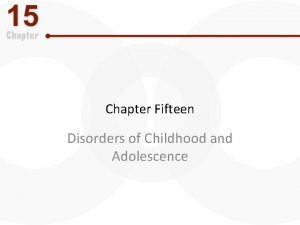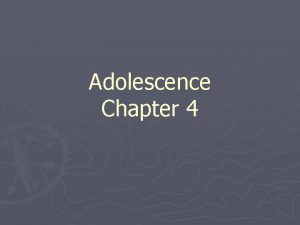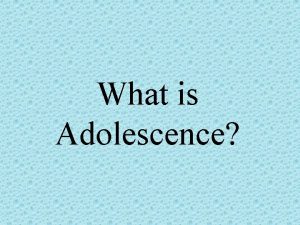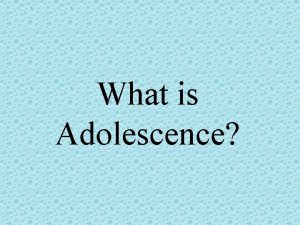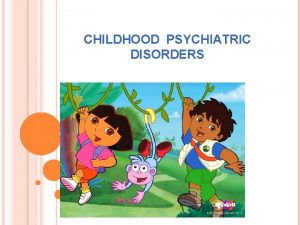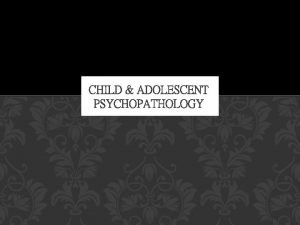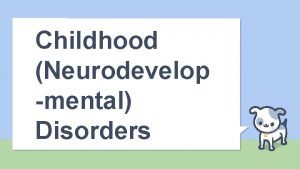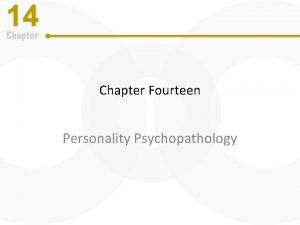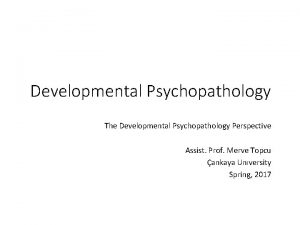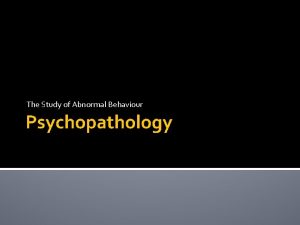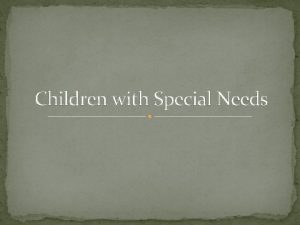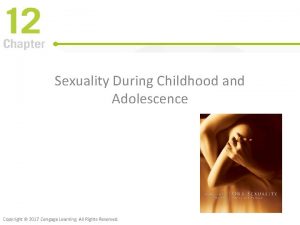PEDIATRIC PSYCHOPATHOLOGY Disorders of Childhood and Adolescence Cengage














































- Slides: 46

PEDIATRIC PSYCHOPATHOLOGY Disorders of Childhood and Adolescence © Cengage Learning 2016

INTRODUCTION • Accurate assessment of mental disorders – Requires understanding normal child development and temperament – Symptoms criteria for children differs from adults – Clinician considers child age, developmental level, and environmental factors • Disorders are common among youth – Large percentage go untreated © Cengage Learning 2016

LIFETIME PREVALENCE OF PSYCHIATRIC DISORDERS IN YOUTH AGES 13 -18 © Cengage Learning 2016

INTERNALIZING DISORDERS AMONG YOUTH • Internalizing disorders involve inward-directed emotional symptoms • Anxiety and depressive disorders most common internalizing disorders – Often lead to substance abuse and suicide • Abrupt behavior changes – Assess for possible abuse (physical, sexual, neglect) © Cengage Learning 2016

ANXIETY, TRAUMA, AND STRESSOR-RELATED DISORDERS IN EARLY LIFE • Most common mental health disorder in childhood and adolescence (32%) • Anxiety disorders – Fear and Avoidance undermines Academic, Interpersonal, Daily Fx – Can significantly impact academic and social functioning – Types of anxiety disorders (specific to children) • Separation anxiety disorder • Selective mutism © Cengage Learning 2016

ATTACHMENT DISORDERS • Poor Quality of Attachment with Primary Caretakers – Cause: stressful early environments that lack predictable caretaking and nurturing • Types of attachment disorders – Reactive attachment disorder (RAD) – https: //www. youtube. com/watch? v=ME 2 wm. Fun. Cj. U – Disinhibited social engagement disorder (DSED) © Cengage Learning 2016

POST-TRAUMATIC STRESS DISORDER IN EARLY LIFE • Prominent Sx: recurring, distressing memories of a shocking experience – Threat or witnessing death, serious injury, or sexual violation – Can be a Vicarious Threat Symptoms: – Distressing dreams, intense reactions to cues, playacting, or dissociative reactions – Repetitive Play – Night terrors, Bed Wetting © Cengage Learning 2016

NONSUICIDAL SELF-INJURY (NSSI) • Involves intentionally inflicted superficial wounds – Pain induces a temporary sense of calm and wellbeing • Urge triggered by emotional pain • DSM-5: NSSI a category under study – For diagnosis: episodes happening more than 5 times per year © Cengage Learning 2016

MOOD DISORDERS IN EARLY LIFE • Depressive disorders most prevalent among females and older adolescents – Situational Stressors primary cause during childhood – Biological factors exert more influence during adolescence • Evidence-based treatments – Individual & family-focused therapy, and focus on building resilience; CBT © Cengage Learning 2016

DISRUPTIVE MOOD DYSREGULATION DISORDER • Characterized by chronic irritability and severe mood dysregulation – Results in episodes of temper triggered by common childhood stressors • Diagnosis not made in children 7 or older • Predicts depressive or anxiety disorders later in life © Cengage Learning 2016

PEDIATRIC BIPOLAR DISORDER (PBD) • Rapid Cycling more common – Hypomanic/manic episodes may alternate with depressive/irritable episodes – Nighttime food binges; Aggression • Elevated neurological responsiveness to emotional stimuli and various brain abnormalities have been found • May be overdiagnosed/misdx – Confused with ADHD © Cengage Learning 2016

DISRUPTIVE MOOD DYSREGULATION DISORDER AND PEDIATRIC BIPOLAR DISORDER © Cengage Learning 2016

EXTERNALIZING DISORDERS • Disruptive, impulse control, and conduct disorders – negative parent-child interaction-both cause and effect • High family stress and negative feelings about parenting • Early intervention is key – Diagnosing these disorders is controversial • Difficult to distinguish from normal defiance/noncompliance © Cengage Learning 2016

OPPOSITIONAL DEFIANT DISORDER (ODD) • Pattern of negativistic, argumentative, and hostile behavior – Loss of temper – Argue and defy adult requests – Primarily directed toward parents, teachers, and others in authority – No serious violation of societal norms • Symptoms often resolve – Especially with intervention © Cengage Learning 2016

INTERMITTENT EXPLOSIVE DISORDER • Prevalent, persistent, and seriously impairing disorder – Both underdiagnosed and undertreated • Involves recurrent outbursts of verbal or physical aggression • Symptom frequency – Twice weekly for at least three months, or three outbursts per year that result in injury or property damage © Cengage Learning 2016

CONDUCT DISORDER (CD) • Persistent pattern of antisocial behavior that violates rights of others – Requires presence of at least three different behaviors • Aggression, bullying, cruelty to people or animals, property destruction, theft or deceit, serious rules violations • Those with CD exhibit limited prosocial emotions • Significant concern to the public © Cengage Learning 2016

OPPOSITIONAL DEFIANT, INTERMITTENT EXPLOSIVE, AND CONDUCT DISORDER © Cengage Learning 2016

TREATMENT OF EXTERNALIZING DISORDERS • Family Therapy – Significant improvement seen – conflict management; communication – Parent-focused interventions effective • Healthy assertiveness and anger management techniques • Mobilizing adult mentors who demonstrate empathy, warmth, and acceptance © Cengage Learning 2016

ELIMINATION DISORDERS • Enuresis – Periodic voiding of urine during the day or night into clothes, bed, or floor – Usually involuntary – Most likely to occur during sleep – Diagnostic criteria • Must be at least five years old and void inappropriately at least twice a week for three months or more – Prevalence varies with age of the child © Cengage Learning 2016

ENCOPRESIS • Defecation onto clothes, floor, or other inappropriate places • Diagnosis – Must be at least four years old and have defecated inappropriately at least once a month for three months or more • Typical pattern – History of constipation and withholding of painful bowel movements © Cengage Learning 2016

NEURODEVELOPMENTAL DISORDERS • Involve impaired development of the brain and central nervous system • Increasingly evident as child gets older • Types – Tic disorders – Attention-deficit hyperactivity disorder – Autism spectrum disorders – Intellectual and learning disorders © Cengage Learning 2016

TICS AND TOURETTE’S DISORDER • Tics – Recurrent, sudden, involuntary, nonrhythmic motor movements or vocalizations – Examples of motor tics • Blinking, grimacing, jerking the head, tapping, flaring nostrils and contracting the shoulders – Examples of vocal tics • Coughing, grunting, throat-clearing, sniffling, or sudden, repetitive, and stereotyped outburst of words © Cengage Learning 2016

TICS • Short-term suppression of a tic is possible – Often results in subsequent increases in the tic • Tension may build prior to tic, followed by a sense of relief after tic occurs • Symptoms often peak prior to puberty • Symptoms often temporary and may disappear without treatment – Due to neuroplastic brain reorganization © Cengage Learning 2016

TOURETTE’S DISORDER (TD) • Characterized by multiple motor tics and one or more vocal tic – Present for at least one year • Coprolalia – Involuntary uttering of obscenities or inappropriate remarks – Present in ten percent of those with TD • Comorbid conditions often more disruptive than the tics themselves © Cengage Learning 2016

ATTENTION-DEFICIT HYPERACTIVITY DISORDER • Characterized by inattention and/or hyperactivity and impulsivity • Diagnostic requirements – Symptoms begin before age 12 and persist for at least six months – Symptoms interfere with social, academic, or occupational activities – Display symptoms in at least two settings • Most frequently diagnosed disorder in preschool and school-age children © Cengage Learning 2016

CHARACTERISTICS OF ATTENTIONDEFICIT/HYPERACTIVITY DISORDER © Cengage Learning 2016

ATTENTION-DEFICIT HYPERACTIVITY DISORDER: ETIOLOGY • Biological dimension – Highly heritable with up to 80% of symptoms explainable by genetic factors • Exact nature is unclear – Hypotheses about neurological mechanisms • Abnormalities in prefrontal cortex • Brain structure and circuitry irregularities in frontal cortex, cerebellum, and parietal lobes • Reduction in neurotransmitters © Cengage Learning 2016

PSYCHOLOGICAL, SOCIAL, AND SOCIOCULTURAL CONSEQUENCES OF ADHD • Social adversity • Stressors in family • Cultural and regional expectations • Interpersonal conflict • Exercise and outdoor activity – Reduces risk of ADHD symptoms © Cengage Learning 2016

TREATMENT OF ADHD • Stimulants such as Ritalin have been used for decades – Normalize neurotransmitter functioning – 30 percent do not respond or experience significant side effects – Still considered first-line treatment approach – Likelihood of medication use greatest for those with severe symptoms • Behavioral and psychosocial treatment shown © Cengage Learning 2016 effective

AUTISM SPECTRUM DISORDERS • Characterized by significant impairment in social fx – Stereotyped interests and behaviors • Symptoms range from mild to severe • Occurs 5 x boys • Prevalence has increased over 120 percent between 2002 and 2010 – Expanded awareness, possible unknown influences © Cengage Learning 2016

SYMPTOMS OF AUTISM SPECTRUM DISORDER • Deficits in social communication and social interaction – Deficit in social-emotional reciprocity – Deficit in Pragmatic Language – Difficulties developing and maintaining relationships © Cengage Learning 2016

ASD SYMPTOMS (CONT’D. ) • Repetitive behavior or restricted interests or activities involving at least two of following: – Repetitive speech, movement, or use of objects – Intense focus on rituals or routines and strong resistance to change – Intense fixations or restricted interests – Atypical sensory reactivity – Acquisition of Language © Cengage Learning 2016

OTHER FACTS ABOUT AUTISM SPECTRUM DISORDERS • Not diagnosed before the age of four • ASD highly linked with declining eye gaze beginning from a young age (2 months) – Encouraging sign towards early diagnosis • Intense, early intervention has reversed progression and eliminated the disorder in some children © Cengage Learning 2016

AUTISM SPECTRUM DISORDERS: ETIOLOGY • Biological influences – Strong genetic influence • Twins and siblings • Degree of impairment varies • ASD linked with neurological findings – Unique patterns of metabolic brain activity – Reduced gaze towards eye regions of faces – High serotonin levels – Accelerated growth of amygdala © Cengage Learning 2016

RECENT RESEARCH FINDINGS • Careful analysis of postmortem brains of children with ASD found patchy areas of disrupted neuronal development – Suggests brain abnormalities begin during pregnancy in the normal cell-layering process • Effect of genetic mutations occur during fetal development • Children with ASD metabolize environmental toxins differently © Cengage Learning 2016

GEOGRAPHIC AND YEAR-TO-YEAR COMPARISON OF PREVALENCE OF ASD © Cengage Learning 2016

ASD INTERVENTION AND TREATMENT • Prognosis is guarded – Behavioral Treatment Primary – Most children retain diagnosis and require support throughout lifetime • Individuals with milder symptoms may be self-sufficient and successfully employed – Social awkwardness, restrictive interests, or atypical behaviors often persist • Significant recovery linked with intense early intervention © Cengage Learning 2016

INTELLECTUAL DISABILITY (ID) • Formerly referred to as mental retardation • Characterized by limitations in intellectual functioning and adaptive behaviors • Four distinct categories – Mild – Moderate – Severe – Profound © Cengage Learning 2016

ETIOLOGY OF INTELLECTUAL DISABILITY • Etiology differs depending on level of intellectual impairment – Mild ID is often idiopathic (no known cause) – Pronounced ID related to genetic factors, brain abnormalities, or brain injury • Genetic factors – 40 genes have been identified • 80 percent reside on the X-chromosome – Fragile X syndrome results in mild to severe ID © Cengage Learning 2016

DOWN SYNDROME (DS) • Most have mild to moderate ID • With support, many adults with DS can have jobs and live semi-independently • Prenatal detection is possible • Environmental influences during pregnancy play a role © Cengage Learning 2016

PSYCHOLOGICAL, SOCIAL, AND SOCIOCULTURAL DIMENSIONS • Genetic background interacts environment- improve prog – Children with socioeconomically advantaged homes often experience enriching activities • Strong, positive influences – Enriching, encouraging home environment – Ongoing education intervention • Religious and cultural beliefs affect parent attitudes and coping strategies © Cengage Learning 2016

LEARNING DISORDERS • Academic disability characterized by reading, math, or writing skills deficits • Primarily interferes with academic achievement and daily living activities requiring reading, writing, or math skills • Prevalence – Approximately five percent of students in public schools – Occurs twice as frequently in boys © Cengage Learning 2016

SUPPORT FOR INDIVIDUALS WITH NEURODEVELOPMENTAL DISORDERS • Goal of intervention – Build skills and develop potential to the fullest extent possible • For those with moderate to severe ID or ASD – Support often begins in infancy and extends across the life span © Cengage Learning 2016

SUPPORT IN ADULTHOOD • Programs focusing on specific job skills • Institutionalization is rare – Many adults live with family members • “Least restrictive environment” possible – As much independence and personal choice as is safe and practical – Many assisted living environments promote social interaction with the larger community © Cengage Learning 2016

CONTEMPORARY TRENDS AND FUTURE DIRECTIONS • The root of many adult mental disorders lies in a stressful childhood – Prevention programs to improve family functioning is a high priority – Evidence-based interventions that promote resilience in children who have experienced maltreatment – Research to address long-term risks and assess intervention efficacy © Cengage Learning 2016

REVIEW • What internalizing disorders occur in childhood and adolescence? • What are the characteristics of externalizing disorders? • What are elimination disorders? • What are neurodevelopmental disorders? © Cengage Learning 2016
 Middle childhood
Middle childhood Adolescent egocentrism
Adolescent egocentrism The developing person through childhood 7th edition
The developing person through childhood 7th edition Eating a balanced diet during childhood and adolescence
Eating a balanced diet during childhood and adolescence The developing person through childhood and adolescence
The developing person through childhood and adolescence Developing person through childhood
Developing person through childhood Infancy childhood adolescence adulthood old age
Infancy childhood adolescence adulthood old age Chapter 11 childhood and neurodevelopmental disorders
Chapter 11 childhood and neurodevelopmental disorders Communication disorders (dsm-5 ppt)
Communication disorders (dsm-5 ppt) Biological paradigm of psychopathology
Biological paradigm of psychopathology Multipath model of psychopathology
Multipath model of psychopathology Multidimensional approach to psychopathology
Multidimensional approach to psychopathology What is psychopathology
What is psychopathology The supernatural tradition
The supernatural tradition Garrett's model of speech production
Garrett's model of speech production Psychopathology
Psychopathology Developmental psychopathology approach
Developmental psychopathology approach Integrative approach to psychopathology
Integrative approach to psychopathology Challenges of middle and late adolescence
Challenges of middle and late adolescence Adolescence and emerging adulthood a cultural approach
Adolescence and emerging adulthood a cultural approach Sequence and series cengage
Sequence and series cengage Properties of determinants
Properties of determinants Cengage anatomy and physiology
Cengage anatomy and physiology Undefined status adolescence
Undefined status adolescence Adolescence vocabulary
Adolescence vocabulary Chapter 6 the adolescent in society
Chapter 6 the adolescent in society Developmental tasks for adolescent
Developmental tasks for adolescent Deborah milbauer northeastern
Deborah milbauer northeastern Eduard spranger dominant values theory
Eduard spranger dominant values theory Moral development in adolescence
Moral development in adolescence Late adolescence
Late adolescence Objectives of adolescence education
Objectives of adolescence education Intimacy vs isolation age
Intimacy vs isolation age Adolescense period
Adolescense period What are the challenges of adolescence
What are the challenges of adolescence Adolescence in our society
Adolescence in our society Psychosocial development in adolescence
Psychosocial development in adolescence Physical development in adolescence
Physical development in adolescence Developmental tasks for adolescent
Developmental tasks for adolescent Undefined status sociology definition
Undefined status sociology definition It is a self portrait composed of many pieces
It is a self portrait composed of many pieces Adolescent age range psychology
Adolescent age range psychology Adolescence
Adolescence Les avantages de l'adolescence
Les avantages de l'adolescence Vocabulary activity 4-2 personal development
Vocabulary activity 4-2 personal development Social changes in adolescence
Social changes in adolescence Chapter 4 adolescence psychology
Chapter 4 adolescence psychology

